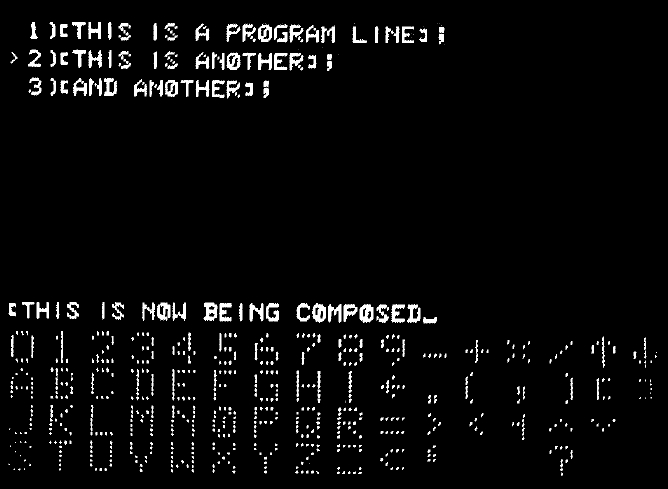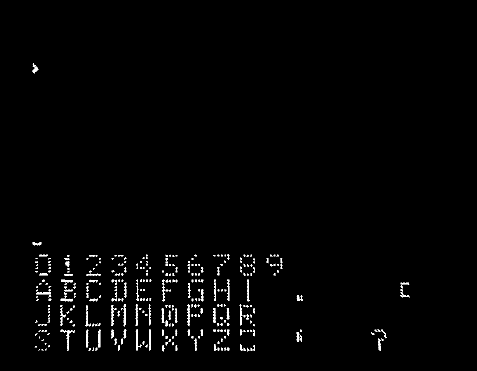DIALOG(ID:251/dia007)
Interactive math using graphics tablet
Illinois Inst Tech, 1966. Interactive math using graphics tablet. Symbols picked off list
Derived from JOSS, but with use of the RAND tablet for input
Structures:
Related languages
| JOSS | => | DIALOG | Enhancement of |
References:
in [ACM] CACM 9(10) October 1966 view details
in [ACM] CACM 9(10) October 1966 view details
in Karplus, W. J. ed. "On-Line Computing", McGraw-Hill, New York, 1967 view details
in Karplus, W. J. ed. "On-Line Computing", McGraw-Hill, New York, 1967 view details
DIALOG is a conversational programming system with a graphical orientation described by Cameron et al. (1967). The language was designed by the IIT Research Institute, Chicago, Illinois, "...as an experimental development intended to explore the effectiveness of an on-line graphical communication terminal as an algebraic programming tool. The system relies entirely on a graphical stylus and a single pushbutton to provide input and, when used on-line, does not make use of a mechanical keyboard."
The language is designed to be used as a computational aid for a casual user. To facilitate use by untrained personnel, online DIALOG programs are composed by selecting symbols from a list displayed on an on-line oscilloscope. The list of displayed symbols is restricted to those symbols whose choice will result in a syntactically correct program. A few lines of code will illustrate the type of statements that occur in DIALOG programs.
12.1 K=KT(B-Y).(X T 2-[-A T 2);
12.6 'WRITE' K, A, B
13.3 'PLOT' (A,B)
An interpretive processor for DIALOG programs has been coded for the UNIVAC 1105 and embedded in a time-sharing monitor that allows simultaneous operation of several terminals. Programs can be prepared off-line, run as batch programs, and can produce hard copy of results as well as the on-line mode of operation. In fact, a DIALOG compiler has been prepared for use on the IBM 7094 for strictly batch operation.
in [ACM] ACM Computing Surveys 2(4) Dec1970 view details
in Proceedings of the International Computing Symposium 1973, Davos view details
The exact number of all the programming languages still in use, and those which are no longer used, is unknown. Zemanek calls the abundance of programming languages and their many dialects a "language Babel". When a new programming language is developed, only its name is known at first and it takes a while before publications about it appear. For some languages, the only relevant literature stays inside the individual companies; some are reported on in papers and magazines; and only a few, such as ALGOL, BASIC, COBOL, FORTRAN, and PL/1, become known to a wider public through various text- and handbooks. The situation surrounding the application of these languages in many computer centers is a similar one.
There are differing opinions on the concept "programming languages". What is called a programming language by some may be termed a program, a processor, or a generator by others. Since there are no sharp borderlines in the field of programming languages, works were considered here which deal with machine languages, assemblers, autocoders, syntax and compilers, processors and generators, as well as with general higher programming languages.
The bibliography contains some 2,700 titles of books, magazines and essays for around 300 programming languages. However, as shown by the "Overview of Existing Programming Languages", there are more than 300 such languages. The "Overview" lists a total of 676 programming languages, but this is certainly incomplete. One author ' has already announced the "next 700 programming languages"; it is to be hoped the many users may be spared such a great variety for reasons of compatibility. The graphic representations (illustrations 1 & 2) show the development and proportion of the most widely-used programming languages, as measured by the number of publications listed here and by the number of computer manufacturers and software firms who have implemented the language in question. The illustrations show FORTRAN to be in the lead at the present time. PL/1 is advancing rapidly, although PL/1 compilers are not yet seen very often outside of IBM.
Some experts believe PL/1 will replace even the widely-used languages such as FORTRAN, COBOL, and ALGOL.4) If this does occur, it will surely take some time - as shown by the chronological diagram (illustration 2) .
It would be desirable from the user's point of view to reduce this language confusion down to the most advantageous languages. Those languages still maintained should incorporate the special facets and advantages of the otherwise superfluous languages. Obviously such demands are not in the interests of computer production firms, especially when one considers that a FORTRAN program can be executed on nearly all third-generation computers.
The titles in this bibliography are organized alphabetically according to programming language, and within a language chronologically and again alphabetically within a given year. Preceding the first programming language in the alphabet, literature is listed on several languages, as are general papers on programming languages and on the theory of formal languages (AAA).
As far as possible, the most of titles are based on autopsy. However, the bibliographical description of sone titles will not satisfy bibliography-documentation demands, since they are based on inaccurate information in various sources. Translation titles whose original titles could not be found through bibliographical research were not included. ' In view of the fact that nany libraries do not have the quoted papers, all magazine essays should have been listed with the volume, the year, issue number and the complete number of pages (e.g. pp. 721-783), so that interlibrary loans could take place with fast reader service. Unfortunately, these data were not always found.
It is hoped that this bibliography will help the electronic data processing expert, and those who wish to select the appropriate programming language from the many available, to find a way through the language Babel.
We wish to offer special thanks to Mr. Klaus G. Saur and the staff of Verlag Dokumentation for their publishing work.
Graz / Austria, May, 1973
in Proceedings of the International Computing Symposium 1973, Davos view details
Resources
- Image of the Dialog terminal

- Layout of the Dialog screen

- Animation of DIALOG session

- Animated dialog session with errors
